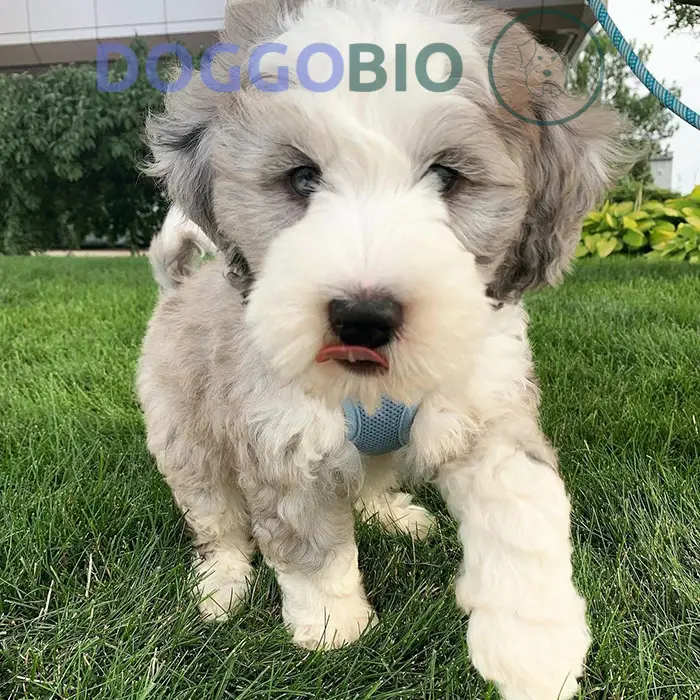Welcome to the enchanting world of the “Merle Bernedoodle” – a captivating canine blend that perfectly combines intelligence, affection, and unique appearance.
Bred from two beloved and renowned breeds, the Bernese Mountain Dog and the Poodle, the Merle Bernedoodle has emerged as a delightful crossbreed cherished by dog enthusiasts worldwide.
In this article, we will explore their fascinating origins, unique traits, and the care required to make them beloved members of your family.
A Brief Overview of Merle Bernedoodle
| Appearance | Medium-sized dog with a curly to wavy coat. Coat color is a marbled pattern of black, gray, and white (blue merle) or brown, apricot, and white (chocolate merle). |
| Size | Standard: 23-29 inches tall, 65-90 pounds; Mini: 17-22 inches tall, 40-55 pounds; Tiny: 12-17 inches tall, 25-35 pounds |
| Temperament | Playful, affectionate, intelligent, friendly, loyal |
| Energy Level | Moderate-high; requires daily exercise and mental stimulation |
| Lifespan | 12-15 years |
| Grooming Needs | Regular brushing (at least weekly), professional grooming every 6-8 weeks |
| Shedding | Low to non-shedding |
| Trainability | Highly trainable; responds well to positive reinforcement |
| Potential Health Concerns | Hip dysplasia, elbow dysplasia, ear infections, eye problems |
| Best Suited For | Active families, individuals with allergies, experienced dog owners |
What is a Merle Bernedoodle?

A Merle Bernedoodle is a dog with a unique coat pattern caused by a dilution gene. This gene lightens the original coat color, but the lightening is not uniform; instead, it creates patches of undiluted color scattered across the dog’s body. Interestingly, this dilution process mainly affects the black pigment in the coat.
Merle Bernedoodle Genetics
Merle Bernedoodles come to life by carefully breeding Bernese Mountain and Standard Poodles.
The key player in this unique coat pattern is the Merle gene, which acts as a dilution gene, lightening the dog’s original coat color. As a result of this gene’s expression, the dog’s coat is adorned with captivating black or very dark brown patches and spots of color scattered unevenly throughout.
It’s worth noting that the merle gene is exclusive to domesticated dogs and can naturally appear in certain breeds. This genetic feature is responsible for the remarkable and distinct appearance that Merle Bernedoodles possess, setting them apart with their charming and mesmerizing coat patterns.
What is a Double Merle Bernedoodle?
A Double Merle Bernedoodle is the result of breeding two merle dogs together, known as Double Merle breeding. Unfortunately, this practice comes with significant risks, including a high likelihood of puppies being born blind and deaf or with visual and hearing impairments.
Double Merles lack essential pigments in their inner ears, making them prone to congenital eye defects. It’s important to distinguish Double Merles from people with albinism, as their condition stems from harmful breeding practices rather than albinism.
Moreover, their insufficient pigment makes them more susceptible to skin cancer, compounding their health concerns. Responsible breeders prioritize their dogs’ well-being by avoiding Double Merle breeding to ensure healthier and higher quality lives for the puppies.
What is a Phantom Merle Bernedoodle?
A Phantom Merle Bernedoodle, also known as Ghost or Cryptic Merle, may display minimal or no visible merle pattern, often leading to misidentification as non-merles. Only a DNA test can definitively confirm if a dog is a phantom merle.
When breeding a phantom merle with non-merles, the resulting offspring typically include cryptics and solids, lacking the typical merle pattern.
It’s crucial for breeders to conduct DNA testing to identify phantom merles and prevent unintentional breeding of two merles together, which could produce double merle dogs prone to health issues.
The coats of all Merle Bernedoodles can change over time due to genetics, with noticeable shifts by six weeks of age. While the AKC doesn’t officially recognize the Bernedoodle, you can register a Merle Bernedoodle with the United Bernedoodle Registry.
What Does a Bernedoodle Merle Look Like?
A Merle Bernedoodle boasts a variety of sizes and an athletic physique, enhanced by their fluffy coats. They typically have a solid, well-proportioned head, adorned with a distinctive bushy mustache-like facial hair, giving them a gentle expression.
Their coats can vary in texture, ranging from wavy to straight or curly, inherited from either parent. This diversity adds charm and uniqueness to each Merle Bernedoodle, making them captivating companions with their individual looks.

Size, height, and Weight
Merle Bernedoodles come in three sizes, inherited from Bernese Mountain Dogs and Poodles: toy, mini, and standard. They can range from 12 to 29 inches tall and weigh between 20 to 110 pounds when fully grown.
This variety in size allows prospective owners to choose a dog that suits their lifestyle, making them a versatile and affectionate family pet.
| Size Group | Height | Weight |
| Toy Solid | 10-15 inches | 15-20 pounds |
| Mini Solid | 16-20 inches | 25-50 pounds |
| Standard Solid | 21-27 inches | 55-90 pounds |
Coat colors and Types
Merle Bernedoodles, resulting from Bernese Mountain Dog and Standard Poodle crosses, showcase a unique coat pattern and color palette. Their coats often feature shades of bluish-grey, red, or chocolate, adorned with black or dark brown spots or speckles.
Three common Merle patterns include:
- Merle Phantom: Merle markings on the body with white on the nose, legs, and chest.
- Merle & White: A mix of white and merle markings across the body.
- Tri-color Merle: Black, rust, and white coloring combined with striking Merle markings.
Many Merle Bernedoodles may have light blue or partially blue eyes, or eyes of different colors, known as “wall-eyed.” The enchanting merle pattern can extend to their nose and paws, enhancing their overall charm.
Temperament and Personality
- Merle Bernedoodles inherit gentle, intelligent traits from Bernese Mountain Dogs and the playful nature of Standard Poodles.
- Their hypoallergenic quality, from Poodles, makes them suitable for allergy sufferers.
- With a friendly and curious demeanor, they’re easily trained and adaptable, ideal for families and first-time owners seeking loyal companions.
- They thrive in environments with regular human interaction, as they enjoy companionship and playtime.
Training and Exercise Requirements
Merle Bernedoodles are remarkably intelligent and eager to please, making them receptive to training. Early initiation of basic obedience training is recommended to establish a strong foundation. When training your puppy, avoiding harsh methods and punishments is essential, as these can instill fear in them. Instead, opt for a more practical approach by using words of encouragement and offering tasty reward treats. Positive reinforcement goes a long way in fostering a trusting and cooperative relationship with your furry companion.

Due to their laid-back temperaments, Merle Bernedoodles benefit from regular exercise to keep them fit and healthy. Taking them on long daily walks ensures they stay active and content. Additionally, they thoroughly enjoy interacting and playing with kids and other dogs. Proper training provides they behave well while walking in the neighborhood, creating a harmonious and enjoyable experience for you and your beloved canine.
Grooming and Cleaning
- Merle Bernedoodles sports a dense, curly coat that requires daily brushing and regular cleaning to keep it in tip-top shape. Although they shed very little, brushing helps remove loose fur and dander, reducing the likelihood of excess hair in your home.
- While they may not shed much, these pups still benefit from regular baths, typically every couple of weeks or when they get dirty. Keeping their coat clean and well-groomed ensures they look their best and feel comfortable.
- Additionally, caring for their nails is essential. Trimming their nails every two weeks is recommended.
- Taking care of their dental hygiene is equally crucial. Brushing their teeth at least 3 times a week helps keep their oral health in check and maintains a fresh breath.
With regular grooming and proper care, your dog will look fantastic and feel happy and healthy.
Food and Diet
Providing a balanced diet is crucial for the health of your Merle Bernedoodle. Opt for high-quality dog food to maintain their well-being, as their fluffy coats can conceal their true body condition. Regular vet weigh-ins help monitor their weight, allowing adjustments to their diet if necessary.
When selecting food, avoid store-bought options with filler ingredients like corn and soy, opting instead for protein-rich, low-carb, and low-fat diets containing essential nutrients. Introduce dietary changes gradually to prevent gastrointestinal issues, consulting your vet if needed.
Feed your Merle Bernedoodle twice daily to prevent overeating and potential bloat. Always provide fresh water, ensuring they stay hydrated. With a balanced diet and proper care, your puppy will thrive for years to come.
Life Expectancy and Common Health Issues
As long as the Bernedoodle isn’t a Double Merle, the Merle pattern itself should not negatively impact their health. Merle dogs, including Merle Bernedoodles, can enjoy the same life expectancy and excellent quality of life as solid-colored ones.
The average lifespan of a Merle Bernedoodle is generally between 12 to 18 years. However, it’s essential to note that while most merle dogs lead healthy lives, some may exhibit increased sensitivity to light and have a higher risk of developing skin cancer. However, these concerns do not apply to Bernedoodles but to certain merle dogs.

As a breed, Bernedoodles are more prone to specific health issues, such as hip dysplasia and eye problems, which are not directly linked to the merle pattern but can affect some members of the breed.
- Hip dysplasia is more commonly found in large species, including Bernedoodles. It occurs when the hip joint deteriorates, causing discomfort and mobility issues.
- Regarding eye issues, some Merle Bernedoodles may experience sensitivity to light, partial blindness, or complete blindness. Also, microphthalmia, where the eyes are too small for the skull, may affect some Merle Bernedoodles. In such cases, it may be necessary to remove the affected eyes.
Despite these potential health concerns, responsible breeding practices and regular veterinary check-ups can help ensure the overall well-being of Merle Bernedoodles and minimize the risk of health issues. As with any dog, early detection and proper care are essential to providing them with a happy and healthy life.
How Much is a Merle Bernedoodle?
The average price of a Merle Bernedoodle falls within the range of $3,000 to $5,000. In comparison, regular coated Bernedoodles typically command prices ranging from $2,000 to $4,000. The slight increase in cost for Merle Bernedoodles is attributed to the uniqueness and desirability of the Merle pattern.
The Merle coat pattern is relatively rare and highly sought after, making Merle Bernedoodles more valuable than those with standard coat patterns. The distinctive and captivating appearance of the merle pattern adds to their appeal, resulting in a slightly higher price tag.
How Can I Find a Merle Bernedoodle For Sale?
Finding a reputable Merle Bernedoodle breeder takes research.
- Start with online searches, reviews, and recommendations.
- Meet or call potential breeders to understand their practices and visit their facilities.
- Seeing the parents and reviewing medical history is crucial.
- Ask questions and seek transparency.
If unsure, explore local shelters or rescue organizations for potential companions.
Is a Merle Bernedoodle the Right Dog for You?
The Merle Bernedoodle can make a fantastic addition to your family thanks to its exceptional temperament, charming personality, and hypoallergenic coat.
While they are wonderful companions, it’s important to note that they require proper training during their puppyhood and plenty of love and attention from their owners. While they can be friendly with strangers, they might take some time to warm up before fully letting their guard down.
Their three sizes make them suitable for households of various sizes, and their adaptability allows them to adjust quickly to new environments. Overall, the Merle Bernedoodle is a healthy, affectionate, and loyal family pet that can bring joy and happiness to your home.
List of dogs that are similar to Merle Bernedoodle
Frequently Asked Questions
Are Merle Bernedoodles Rare?
Yes, Merle Bernedoodles are rare.
Merle Bernedoodles are exceptionally rare due to the absence of the merle gene in Bernese Mountain Dogs and Poodles. Breeders introduce the gene by crossing a Merle Poodle with a non-Merle Bernese Mountain Dog or breeding two Merle Bernedoodles together, avoiding double merle breeding to prevent health issues.
Merle Poodles, in turn, often inherit the gene from larger breeds like Australian Shepherds, Collies, or Great Danes, meaning Merle Bernedoodles carry a small percentage of another species in their genetics. This rarity and unique genetic makeup contribute to their high desirability among dog enthusiasts.
Does Bernedoodles Fade?
Yes, Bernedoodles can experience fading if they inherit the ‘fading gene’ from the Poodle side. Solid Bernedoodles are more prone to fading compared to Merle Bernedoodles. Merle Bernedoodles already have a naturally light-colored coat, so any further lightening is minimal.
If fading occurs, it typically occurs within the first two years of their lives. As they mature, the fading process, if present, should become evident during this timeframe.
What is a Blue Merle Bernedoodle?
A Blue Merle Bernedoodle showcases a captivating coat with a blend of blue (black), grey, white, and tan colors arranged in a striking mottled pattern. Their predominant hues are grey and blue, complemented by smaller patches of white and tan throughout the coat.
Blue Merle Bernedoodles commonly possess black noses and may have brown or blue eyes. Initially, they would have had a solid black coat, but the merle gene influenced sections of it to adopt these lighter and more enchanting shades. Their unique coat pattern makes them a highly sought-after and visually stunning breed.
Are Merle Bernedoodles hypoallergenic?
Yes, the Merle Bernedoodle is hypoallergenic. They shed minimally, produce little dander, and are dry-mouthed, making them suitable for individuals with mild to moderate dog allergies.
Conclusion
In conclusion, the Merle Bernedoodle is a true gem among canine companions, seamlessly blending the best qualities of the Bernese Mountain Dog and the Poodle. Their captivating appearance, intelligence, and affectionate nature make them the perfect addition to any loving family. From their fascinating origins to their delightful personalities, the Merle Bernedoodle has won the hearts of dog enthusiasts worldwide.
If you consider welcoming one into your home, rest assured that with proper care and attention, these endearing four-legged friends will bring joy and companionship to your life for many years. Embrace the magic of the Merle Bernedoodle and embark on an unforgettable journey filled with love, laughter, and cherished memories.

Pingback: Australian Bernedoodle: Discover Your Affection Companion2024
Pingback: F1B Bernedoodle Euphoria: Crafting a Blissful Bond 2024
This asset is phenomenal. The wonderful information exhibits the proprietor’s earnestness. I’m stunned and anticipate more such mind blowing entries.